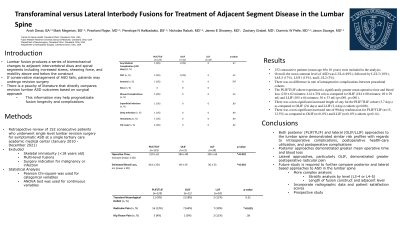Transforaminal versus lateral interbody fusions for treatment of adjacent segment disease in the lumbar spine
Transforaminal versus Lateral Interbody Fusions for Treatment of Adjacent Segment Disease in the Lumbar Spine
Friday, April 21, 2023


Ansh D. Desai
Medical Student
Case Western Reserve University School of Medicine
Cleveland, Ohio, United States
ePoster Presenter(s)
Introduction: Currently, the decision with regards to approach to the lumbar spine for a revision ASD surgery is at the discretion of the operating surgeon. Therefore, this study aimed to compare posterior versus lateral approaches for treatment of ASD by comparing the perioperative and postoperative outcomes in patients who received a posterior lumbar interbody fusion (PLIF)/transforaminal lumbar interbody fusion (TLIF) and lateral lumbar interbody fusion (LLIF)/oblique lateral interbody fusion (OLIF).
Methods: A retrospective review was performed of consecutive patients who underwent a single-level PLIF/TLIF, LLIF, or OLIF for symptomatic ASD at a single tertiary care academic medical center between January 2010 and December 2021. All surgeries were performed by fellowship-trained orthopedic and neurosurgeons. Exclusion criteria included skeletal immaturity (age < 18 years old), multi-level fusions, and surgery indication for malignancy or infection.
Results: After exclusion, 152 consecutive patients (mean age 65± 10 years) were included in the analysis. The PLIF/TLIF cohort experienced a significantly greater mean operative time and blood loss (210 ± 62 minutes; 414 ± 254 ml) as compared to OLIF (184 ± 80 minutes; 49 ± 29 ml) and LLIF (105 ± 64 minutes; 36 ± 33 ml) (p < .001, p < .001). There was a non-significant increased length of stay for the PLIF/TLIF cohort (3.7 days) as compared to OLIF (2.6 days) and LLIF (2.4 days) cohorts (p=0.08).
There was a significantly greater rate of radicular pain for the OLIF cohort (n=7, 63.6%) as compared to LLIF (n=7, 38.9%) and PLIF/TLIF (n=16, 13%) (p < .001). omplication rates were otherwise comparable between procedural cohorts.
Conclusion : Overall, both posterior (TLIF/PLIF) and lateral (OLIF/LLIF) approaches to the lumbar spine demonstrated similar risk profiles with regards to intraoperative complications, post-operative health-care utilization, and post-operative complications. Future prospective study is required to further compare posterior and lateral-based approaches to adjacent segment disease in the lumbar spine.
Methods: A retrospective review was performed of consecutive patients who underwent a single-level PLIF/TLIF, LLIF, or OLIF for symptomatic ASD at a single tertiary care academic medical center between January 2010 and December 2021. All surgeries were performed by fellowship-trained orthopedic and neurosurgeons. Exclusion criteria included skeletal immaturity (age < 18 years old), multi-level fusions, and surgery indication for malignancy or infection.
Results: After exclusion, 152 consecutive patients (mean age 65± 10 years) were included in the analysis. The PLIF/TLIF cohort experienced a significantly greater mean operative time and blood loss (210 ± 62 minutes; 414 ± 254 ml) as compared to OLIF (184 ± 80 minutes; 49 ± 29 ml) and LLIF (105 ± 64 minutes; 36 ± 33 ml) (p < .001, p < .001). There was a non-significant increased length of stay for the PLIF/TLIF cohort (3.7 days) as compared to OLIF (2.6 days) and LLIF (2.4 days) cohorts (p=0.08).
There was a significantly greater rate of radicular pain for the OLIF cohort (n=7, 63.6%) as compared to LLIF (n=7, 38.9%) and PLIF/TLIF (n=16, 13%) (p < .001). omplication rates were otherwise comparable between procedural cohorts.
Conclusion : Overall, both posterior (TLIF/PLIF) and lateral (OLIF/LLIF) approaches to the lumbar spine demonstrated similar risk profiles with regards to intraoperative complications, post-operative health-care utilization, and post-operative complications. Future prospective study is required to further compare posterior and lateral-based approaches to adjacent segment disease in the lumbar spine.
